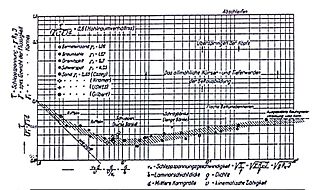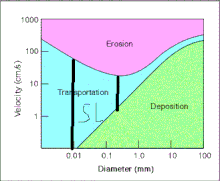
Sediment is a naturally occurring material that is broken down by processes of weathering and erosion, and is subsequently transported by the action of wind, water, or ice or by the force of gravity acting on the particles. For example, sand and silt can be carried in suspension in river water and on reaching the sea bed deposited by sedimentation; if buried, they may eventually become sandstone and siltstone through lithification.

In geography and geology, fluvial processes are associated with rivers and streams and the deposits and landforms created by them. When the stream or rivers are associated with glaciers, ice sheets, or ice caps, the term glaciofluvial or fluvioglacial is used.

Deposition is the geological process in which sediments, soil and rocks are added to a landform or landmass. Wind, ice, water, and gravity transport previously weathered surface material, which, at the loss of enough kinetic energy in the fluid, is deposited, building up layers of sediment.

The term bed load or bedload describes particles in a flowing fluid that are transported along the stream bed. Bed load is complementary to suspended load and wash load.

The Hjulström curve, named after Filip Hjulström (1902–1982), is a graph used by hydrologists and geologists to determine whether a river will erode, transport, or deposit sediment. It was originally published in his doctoral thesis "Studies of the morphological activity of rivers as illustrated by the River Fyris." in 1935. The graph takes sediment particle size and water velocity into account.

Sediment transport is the movement of solid particles (sediment), typically due to a combination of gravity acting on the sediment, and/or the movement of the fluid in which the sediment is entrained. Sediment transport occurs in natural systems where the particles are clastic rocks, mud, or clay; the fluid is air, water, or ice; and the force of gravity acts to move the particles along the sloping surface on which they are resting. Sediment transport due to fluid motion occurs in rivers, oceans, lakes, seas, and other bodies of water due to currents and tides. Transport is also caused by glaciers as they flow, and on terrestrial surfaces under the influence of wind. Sediment transport due only to gravity can occur on sloping surfaces in general, including hillslopes, scarps, cliffs, and the continental shelf—continental slope boundary.

Stream load is a geologic term referring to the solid matter carried by a stream. Erosion and bed shear stress continually remove mineral material from the bed and banks of the stream channel, adding this material to the regular flow of water. The amount of solid load that a stream can carry, or stream capacity, is measured in metric tons per day, passing a given location. Stream capacity is dependent upon the stream's velocity, the amount of water flow, and the gradation.
Wash load is similar to a suspended load, but wash load sediment never interacts with the bed load. All of the sediment in the wash load stays suspended in the water throughout the channel. Wash load refers to a river's ability to move sediment through a channel.
The Rouse number is a non-dimensional number in fluid dynamics which is used to define a concentration profile of suspended sediment and which also determines how sediment will be transported in a flowing fluid. It is a ratio between the sediment fall velocity and the upwards velocity on the grain as a product of the von Kármán constant and the shear velocity .
Shear velocity, also called friction velocity, is a form by which a shear stress may be re-written in units of velocity. It is useful as a method in fluid mechanics to compare true velocities, such as the velocity of a flow in a stream, to a velocity that relates shear between layers of flow.
Ocean dynamics define and describe the motion of water within the oceans. Ocean temperature and motion fields can be separated into three distinct layers: mixed (surface) layer, upper ocean, and deep ocean.

A bedform is a geological feature that develops at the interface of fluid and a moveable bed, the result of bed material being moved by fluid flow. Examples include ripples and dunes on the bed of a river. Bedforms are often preserved in the rock record as a result of being present in a depositional setting. Bedforms are often characteristic to the flow parameters, and may be used to infer flow depth and velocity, and therefore the Froude number.

In fluid mechanics, the Reynolds number is a dimensionless quantity that helps predict fluid flow patterns in different situations by measuring the ratio between inertial and viscous forces. At low Reynolds numbers, flows tend to be dominated by laminar (sheet-like) flow, while at high Reynolds numbers, flows tend to be turbulent. The turbulence results from differences in the fluid's speed and direction, which may sometimes intersect or even move counter to the overall direction of the flow. These eddy currents begin to churn the flow, using up energy in the process, which for liquids increases the chances of cavitation.
Three components that are included in the load of a river system are the following: dissolved load, wash load and bed material load. The bed material load is the portion of the sediment that is transported by a stream that contains material derived from the bed. Bed material load typically consists of all of the bed load, and the proportion of the suspended load that is represented in the bed sediments. It generally consists of grains coarser than 0.062 mm with the principal source being the channel bed. Its importance lies in that its composition is that of the bed, and the material in transport can therefore be actively interchanged with the bed. For this reason, bed material load exerts a control on river channel morphology. Bed load and wash load together constitute the total load of sediment in a stream. The order in which the three components of load have been considered – dissolved, wash, bed material – can be thought of as progression: of increasingly slower transport velocities, so that the load peak lags further and further behind the flow peak during any event.
The Shields parameter, also called the Shields criterion or Shields number, is a nondimensional number used to calculate the initiation of motion of sediment in a fluid flow. It is a nondimensionalization of a shear stress, and is typically denoted or . This parameter has been developed by Albert F. Shields, and is called later Shields parameter. The Shields parameter is the main parameter of the Shields formula. It is given by:

In hydrology stream competency, also known as stream competence, is a measure of the maximum size of particles a stream can transport. The particles are made up of grain sizes ranging from large to small and include boulders, rocks, pebbles, sand, silt, and clay. These particles make up the bed load of the stream. Stream competence was originally simplified by the “sixth-power-law,” which states the mass of a particle that can be moved is proportional to the velocity of the river raised to the sixth power. This refers to the stream bed velocity which is difficult to measure or estimate due to the many factors that cause slight variances in stream velocities.

Subhasish Dey is a hydraulician and educator. He is known for his research on the hydrodynamics and acclaimed for his contributions in developing theories and solution methodologies of various problems on hydrodynamics, turbulence, boundary layer, sediment transport and open channel flow. He is currently a distinguished professor of Indian Institute of Technology Jodhpur (2023–). Before, he worked as a professor of the department of civil engineering, Indian Institute of Technology Kharagpur (1998–2023), where he served as the head of the department during 2013–15 and held the position of Brahmaputra Chair Professor during 2009–14 and 2015. He also held the adjunct professor position in the Physics and Applied Mathematics Unit at Indian Statistical Institute Kolkata during 2014–19. Besides he has been named a distinguished visiting professor at the Tsinghua University in Beijing, China.

A powder snow avalanche is a type of avalanche where snow grains are largely or completely suspended and moved by air in a state of fluid turbulence. They are particle-laden gravity currents and closely related to turbidity currents, pyroclastic flows from volcanoes and dust storms in the desert. The turbulence is typically generated by the forward motion of the current along the lower boundary of the domain, the motion being in turn driven by the action of gravity on the density difference between the particle-fluid mixture and the ambient fluid. The ambient fluid is generally of similar composition to the interstitial fluid, and is water for turbidity currents and air for avalanches. These flows are non-conservative in that they may exchange particles at the lower boundary by deposition or suspension, and may exchange fluid with the ambient by entrainment or detrainment. Such flows dissipate when the turbulence can no longer hold the particles in suspension and they are deposited on the lower boundary. When the turbulence is strong enough to suspend new material from the bed or the underlying dense flow then current is said to be auto-suspending. Particle concentrations in the suspension cloud are usually sufficiently low that particle-particle interactions play a small or negligible role in maintaining the suspension. In powder snow avalanches, even at these low concentrations, the extra density of the suspended particles is large relative to that of air, so the Boussinesq approximation, where density differences are considered negligible in inertia terms, is invalid, so that the snow grains carry most of the flows momentum. This is in contrast to turbidity currents and laboratory experiments in water where the extra inertia of the particles can usually be neglected. Nonetheless, due to the extreme difficulty in estimating particle concentrations in natural flows there remains considerable uncertainty—and debate—concerning the particle loading in large submarine turbidity currents and the validity of the Boussinesq approximation.

The Shields formula is a formula for the stability calculation of granular material in running water.

Albert Frank Shields was an American mechanical engineer who is best known for his derivation of the formula for determining the beginning of movement of sand and gravel in currents. The dimensionless Shields parameter is called after him.
















